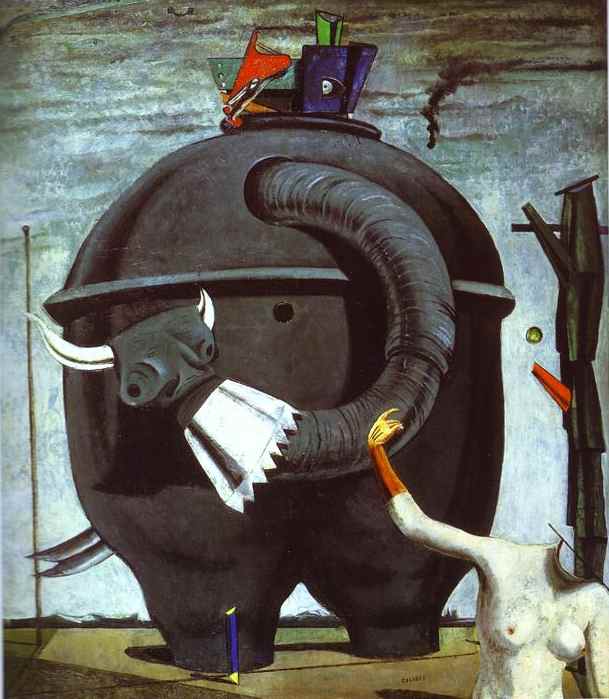
It’s hard to overstate the visceral impact of World War I on the nations who were scarred by it. Part of the shock came from the staggering casualties. In countries where fighting took place, over 16% of the entire population was killed (Serbia), with even major nations like France and Germany lost more than 3 or 4% of their populations. The scale of the devastation was compounded by the sense that modernity itself had betrayed civilization, however. Prior to World War 1 disease was always deadlier than human weapons, but this changed in World War 1. With newly invented weapons science–the guiding light since the dawn of the Enlightenment–had betrayed an entire civilization. The governments, churches, and other modern institutions that created and perpetuated the war without any ability to foresee it’s true cost cast centuries of political and philosophical progress into doubt.

Surrealism (along with its progenitor Dadaism and its successor Postmodernism) was the reaction to this horror. With it, Western society recoiled convulsively from the core conceit of modernity: the supremacy of logic and reason. The Surrealist Manifesto advocated expressing thought in the “absence of all control exercised by reason” and took as its core article of faith “the omnipotence of dream.” When confronted with the War to End All Wars, the surrealists decided that if reality had become the the ultimate nightmare, any and all dreams and hallucinations were superior to reality.
So when I describe American politics as surreal, I want to be very sure that everyone knows exactly what I mean: the core of today’s American politics is defined by the absolute rejection of reality. The difference between the European surrealists of the early 20th century and the sureealism of American politics in the early 21st is that while they were fleeing from nightmares, we flee from each other and, in so doing, create our own nightmares.
The fundamental fantasy of American politics is the solipsistic delusion that no one else is a real person. What I mean by this is that when Americans look at their political opponents they don’t see fellow Americans. They see caricatures. Even more disturbing, however, is that we even conjure up radicalized stereotypes of our ideological allies. Everywhere we look we see fantastic creatures instead of real human beings.
Although I’ve watched with dismay as this gulf grows between my politically diverse friends throughout my entire life, a recent study described at the Huffington Post substantiates what would otherwise be merely anecdata. The study by Graham, Nosek, and Haidt and published in the open access peer-reviewed journal PLOS ONE, found that :
Contrary to common theories of stereotyping, the moral stereotypes were not simple underestimations of the political outgroup’s morality. Both liberals and conservatives exaggerated the ideological extremity of moral concerns for the ingroup as well as the outgroup.

For some background, Moral Foundations Theory (which was co-created by Haidt) posits 6 key dimensions to moral reasoning: harm, fairness, liberty, loyalty, authority, and purity. In this PLOS ONE study, Graham, Nosek and Haidt omitted liberty from consideration, and so had 5 remaining dimensions to morality. They labeled the first two (harm and fairness) as “individuating” and the other 3 (loyalty, authority, and purity) as “binding” and agreed with Haidt’s earlier research (citing 4 additional studies), that “liberals endorsed the individualizing foundations (Harm, Fairness) more than conservatives did, whereas conservatives endorsed the binding foundations (Ingroup, Authority, Purity) more than liberals did.”
In their experiment, the researchers asked over 2,000 volunteers to answer a series of questions first for themselves, and then as if they were answering the questions for a hypothetical person who was described as either conservative or liberal. What they found was that the self-answers (both liberal and conservative) were much closer together than the imaginary ones. When a liberal answered for a generic liberal, they exaggerated the liberal stereotype. When they answered for a generic conservative, they exaggerated the conservative stereotype, and conservatives did the same thing.
If this all sounds a bit abstract, then let me explain why I think it’s the gravest threat our nation faces by providing the same two quotes that Graham, Nosek and Haid did at the beginning of their article. First, representing the conservative side, we have a quote from Joseph Farah on WorldNetDaily:
The national Democratic Party is immoral to the core. Any American who would vote for Democrats is guilty of fostering the worst kind of degeneracy. The leaders of this party are severely out of touch with mainstream, traditional American values. They are crusaders for perversion, for licentiousness, for nihilism and worse.
Then, speaking for the liberals, we have a quote from Michael Feingold writing in the Village Voice:
Republicans don’t believe in the imagination, partly because so few of them have one, but mostly because it gets in the way of their chosen work, which is to destroy the human race and the planet. Human beings, who have imaginations, can see a recipe for disaster in the making; Republicans, whose goal in life is to profit from disaster and who don’t give a hoot about human beings, either can’t or won’t.
If we could write these off as shrill exceptions that would be bad enough, but we can’t. The research from Graham, Nosek and Haidt (and others) shows that this radicalized surrealism is pervasive. It’s also dangerous in two crucial ways
- To the extent that actual American politics are represented there’s no hope of real compromise.
- You can’t really represent all of American politics with two “sides”, but this polarity prevents innovation.
Both of these problems arise in the same way: the constant belief that the other is out to annihilate everything that is good and beautiful in the world creates a sense of perpetual panic. Any compromise with the adversary or wandering off thinking about things beyond the rudimentary party line could create a crack in the defense allowing the other guys to triumph. Nothing could be worse than that of course.
Here’s what I believe:
First, I believe that Americans from the left and right often do have common intuitions, goals, and aspirations that are masked by differing terminology and buried under pseudo-conflict. Second, I believe that not only compromise but positive political innovation are possible when the standoff can be defused and common ground can be accessed. Third, I believe that no matter how small any individuals influence may be, we all have a civic and moral imperative to opt out of the fear machine and engage in good faith discussion across ideological lines.
Right now the politicians are powerless to effect positive change because their incentives are dictated by our preferences. As long as we the people allow ourselves to be divided so starkly into warring camps we can forget any responsibility or maturity from Washington. Of course this doesn’t excuse individual acts of cravenness and corruption, but practically speaking we either improve American society or we go down with the ship in one way or another (none of which are pleasant to imagine).
So, starting with this post, I’m going to do my part to put my money where my mouth is. I have ideas for real reform that fall outside the convenient definitions of right and left that could make our country a better place and, I think, find broad support. I have no idea if anything I write will ever have an impact. I hope in some tiny way it will. But, regardless of the outcome, I believe that our nation needs a reboot and that it has to come from the citizens first. It’s an idea I think of as America 2.0, and I’m starting work on it today.